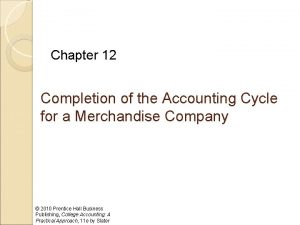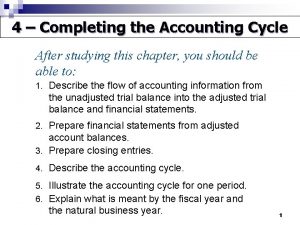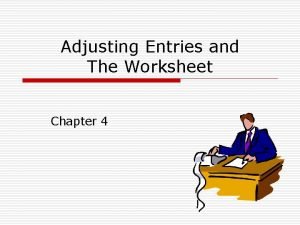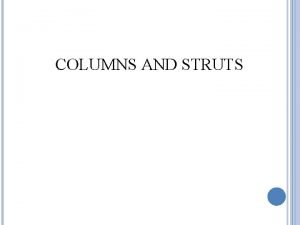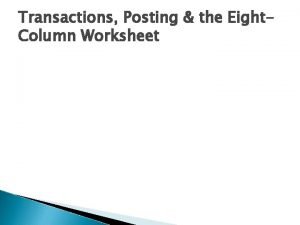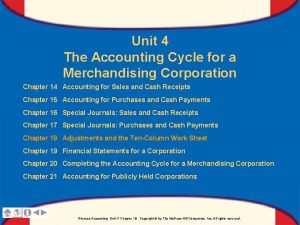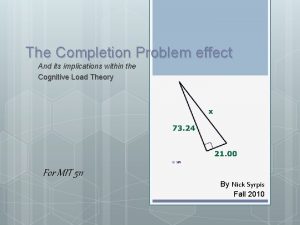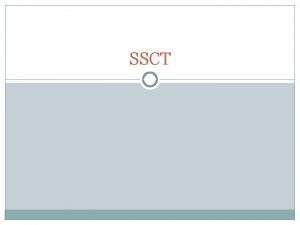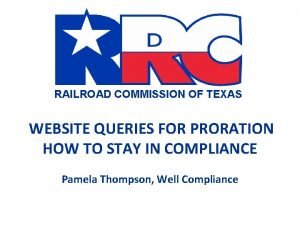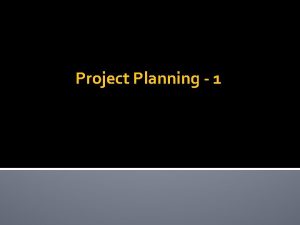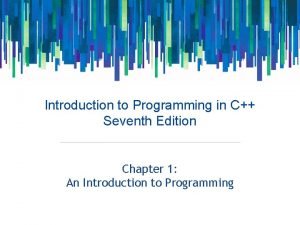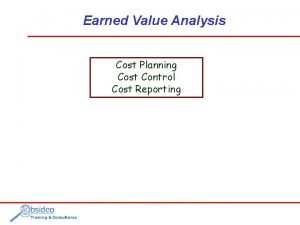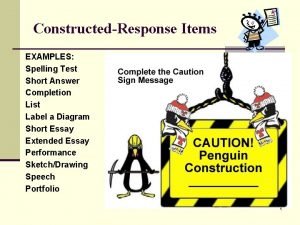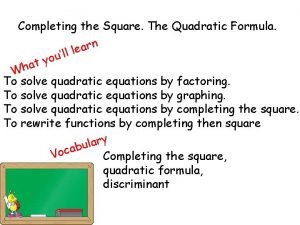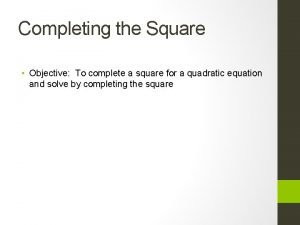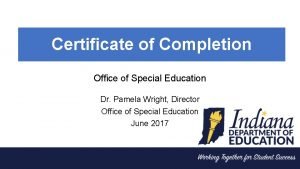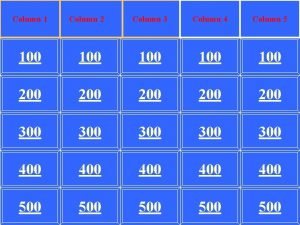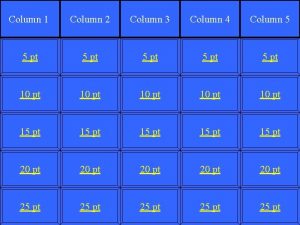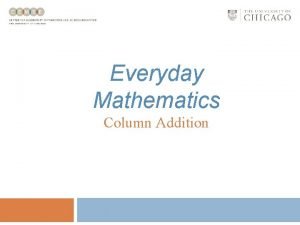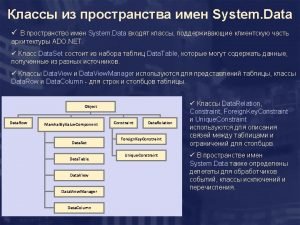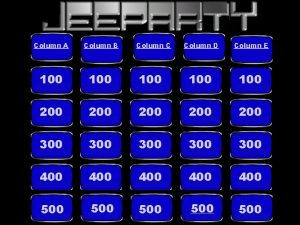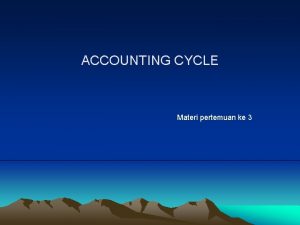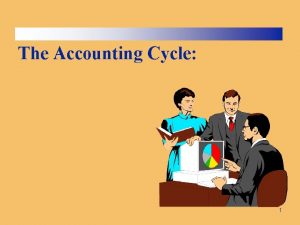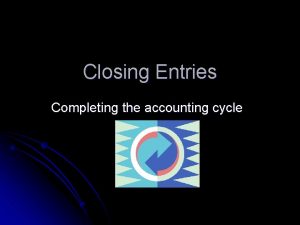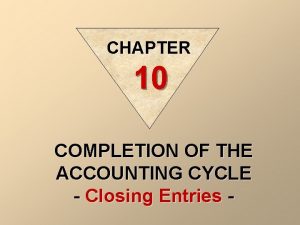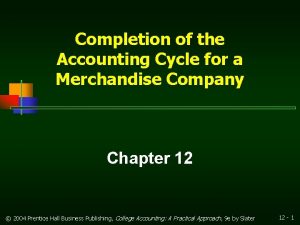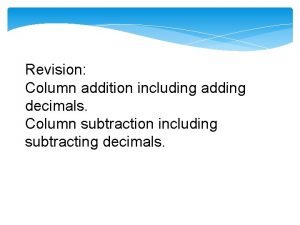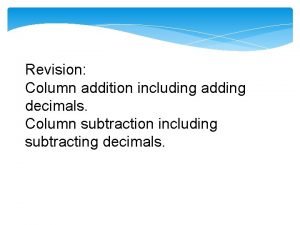COMPLETION Accounting Cycle joemargarciacunanan WORKSHEET The 10 column


























- Slides: 26

COMPLETION Accounting Cycle -joemargarciacunanan

WORKSHEET

The 10 column Worksheet • The worksheet is a columnar device to facilitate the preparation of the financial statements by making it easier to transfer data from the trial balance to the financial statements.

Contents of the Worksheet • Heading, which consists of three lines: a. Name of the company, b. Title – Worksheet, and c. Period covered • Column for account titles, and ten money columns arranged in five pairs of debit and credit columns. • The figures which have been lifted from the accounting records of the company.

Example of Worksheet

FINANCIAL STATEMENTS

Preparation of Financial Statements • After the completion of the worksheet, the financial statements are prepared in the following order: a. Statement of Comprehensive Income (Income Statement) b. Statement of Changes in Equity c. Statement of Financial Position (Balance Sheet) d. Statement of Cash Flows • Financial Statements are normally issued together with another document, such as an annual report of a company.

Statement of Comprehensive Income (Income Statement) • The statement of comprehensive income presents two types of information: – Income, expenses and the performance of the company, which is either net income or loss – Components of other comprehensive income

Elements of FS included in Income Statement • Income – represents the result of the profit-directed activities of the business which increases owner’s equity • Expenses – represent decreases in the owner’s equity caused by the revenue-generating activities of the business Profit – represents excess of total revenues over total expenses. When the expenses exceed the revenues, the net income becomes a net loss. If equal, it is called breakeven.

Example of Income Statement

Statement of Changes in Equity (Capital Statement) • A business shall present a statement which shows how the entity’s equity has changed during the period. For a sole proprietorship, the statement of changes in equity discloses the ff. info: – – – Beginning balance of equity Any additional investments made by the proprietor The profit or loss for the period Withdrawals by the owner during the period Ending balance of equity

Example of Capital Statement

Statement of Financial Position (Balance Sheet) • A Statement of Financial Position is a formal statement of the assets, liabilities and owner’s equity of the business as of a given date. • Formats of Balance Sheet – Report form – simply list the assets, liabilities and the capital in a downward sequence. – Account form – List the assets on the left side while the liabilities and capital on the right side.

Example of Balance Sheet

Statement of Cash Flows • Cash inflows or outflows are classified into the ff. categories: – Operating activities – principal revenue producing activities of the enterprise. – Investing activities – acquisition and disposal of long term assets and other investments – Financing activities – are activities that result in changes in the size and composition of owner’s equity and liabilities of the enterprise.

Example of Cash Flow Statement

JOURNALIZING AND POSTING ADJUSTING ENTRIES

Journalizing and Posting Adjusting Entries • After the financial statements are prepared, the adjusting entries are recorded in the general journal and posted to the general ledger. The adjusting entries can be taken directly from the adjustments columns of the worksheet

Example of Posting Adjusting Entries

CLOSING ENTRIES

Closing Entries • Elements of Financial Statements – Assets – Liabilities – Capital/Owner’s Equity – Income – Expenses

Closing Entries • Separate accounts for income, expenses and drawings are set up only to facilitate the preparation of the income statement for a particular accounting period. At the end of each accounting period, these accounts have served their purpose and will be closed to the equity account.

Closing Entries • Real Accounts – are balance sheet accounts (assets, liabilities, and capital) which are not reduced to zero at the end of every accounting period. • Nominal accounts – Income, Expense and Drawing, they are temporary in nature and are reduced to zero at the end of every accounting period.

Procedures in closing the nominal accounts • A summary account called Income Summary is used to close all revenue and expense accounts. • Close all revenue accounts by debiting the amount of the credit balances and crediting the Income Summary account. • Close all expense accounts by debiting the Income Summary account and crediting the amounts of the debit balances • Close the balance of the Income Summary account to the owner’s equity account • Close the drawing account to the owner’s equity account.

POST CLOSING TRIAL BALANCE

Preparation of the Post Closing Trial Balance • The final step to complete the end of period work is the preparation of the post closing trial balance. The purpose of the post closing trial balance is to check the equality of debits and credits in the ledger after the adjusting and closing entries are recorded and posted. • At this point, the only accounts with balances are the assets, contra assets, liabilities and capital or the balance sheet accounts.
 Completion of the accounting cycle
Completion of the accounting cycle 10 column worksheet example
10 column worksheet example Completing the accounting cycle
Completing the accounting cycle Chapter 4 completion activity
Chapter 4 completion activity 10 column worksheet adjusting entries
10 column worksheet adjusting entries Both end hinged column
Both end hinged column Eight column worksheet
Eight column worksheet Journalizing adjusting entries
Journalizing adjusting entries Subsea well completions
Subsea well completions Unit 13 biological cultural and chemical control of pests
Unit 13 biological cultural and chemical control of pests Sentence completion task
Sentence completion task Completion problems
Completion problems Ssct adalah
Ssct adalah The presentation of
The presentation of Semantic scene completion from a single depth image
Semantic scene completion from a single depth image Rrc wellbore query
Rrc wellbore query Adequate planning leads to the correct completion of work
Adequate planning leads to the correct completion of work The selection structure is the completion of
The selection structure is the completion of Completion point linguistics
Completion point linguistics Estimate at completion
Estimate at completion Spelling of completion
Spelling of completion Rewrite the function by completing the square
Rewrite the function by completing the square Completing the square purpose
Completing the square purpose Percentage of completion method
Percentage of completion method Chapter 11 completion activity
Chapter 11 completion activity Certificate of completion special education
Certificate of completion special education Intensive speaking example
Intensive speaking example
